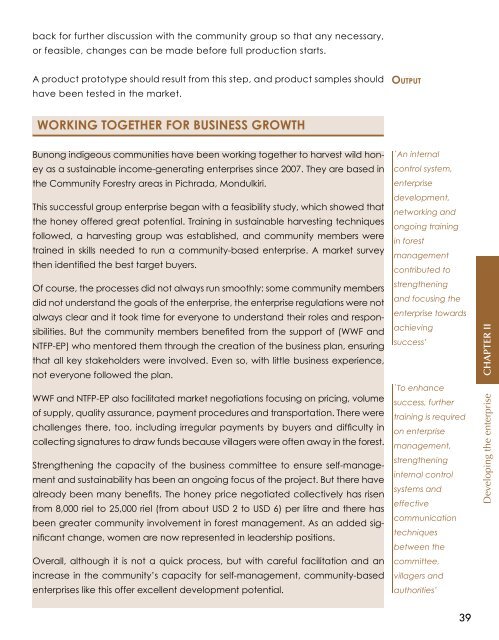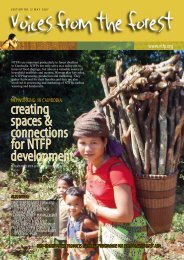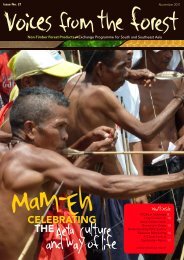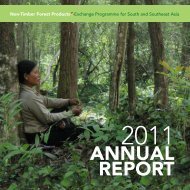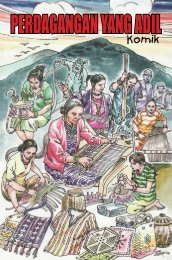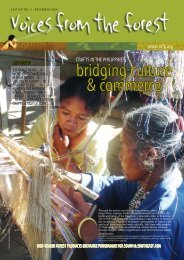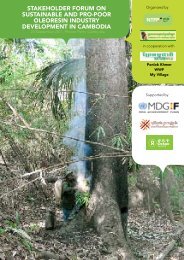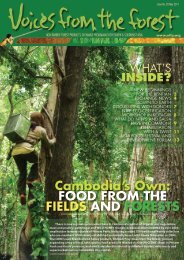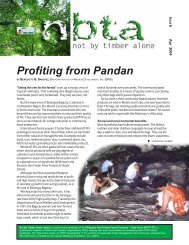Download PDF - Non-Timber Forest Products Exchange Programme
Download PDF - Non-Timber Forest Products Exchange Programme
Download PDF - Non-Timber Forest Products Exchange Programme
You also want an ePaper? Increase the reach of your titles
YUMPU automatically turns print PDFs into web optimized ePapers that Google loves.
ack for further discussion with the community group so that any necessary,<br />
or feasible, changes can be made before full production starts.<br />
A product prototype should result from this step, and product samples should<br />
have been tested in the market.<br />
Output<br />
Working together for business growth<br />
Bunong indigeous communities have been working together to harvest wild honey<br />
as a sustainable income-generating enterprises since 2007. They are based in<br />
the Community <strong>Forest</strong>ry areas in Pichrada, Mondulkiri.<br />
This successful group enterprise began with a feasibility study, which showed that<br />
the honey offered great potential. Training in sustainable harvesting techniques<br />
followed, a harvesting group was established, and community members were<br />
trained in skills needed to run a community-based enterprise. A market survey<br />
then identified the best target buyers.<br />
Of course, the processes did not always run smoothly: some community members<br />
did not understand the goals of the enterprise, the enterprise regulations were not<br />
always clear and it took time for everyone to understand their roles and responsibilities.<br />
But the community members benefited from the support of (WWF and<br />
NTFP-EP) who mentored them through the creation of the business plan, ensuring<br />
that all key stakeholders were involved. Even so, with little business experience,<br />
not everyone followed the plan.<br />
WWF and NTFP-EP also facilitated market negotiations focusing on pricing, volume<br />
of supply, quality assurance, payment procedures and transportation. There were<br />
challenges there, too, including irregular payments by buyers and difficulty in<br />
collecting signatures to draw funds because villagers were often away in the forest.<br />
Strengthening the capacity of the business committee to ensure self-management<br />
and sustainability has been an ongoing focus of the project. But there have<br />
already been many benefits. The honey price negotiated collectively has risen<br />
from 8,000 riel to 25,000 riel (from about USD 2 to USD 6) per litre and there has<br />
been greater community involvement in forest management. As an added significant<br />
change, women are now represented in leadership positions.<br />
Overall, although it is not a quick process, but with careful facilitation and an<br />
increase in the community’s capacity for self-management, community-based<br />
enterprises like this offer excellent development potential.<br />
`An internal<br />
control system,<br />
enterprise<br />
development,<br />
networking and<br />
ongoing training<br />
in forest<br />
management<br />
contributed to<br />
strengthening<br />
and focusing the<br />
enterprise towards<br />
achieving<br />
success’<br />
`To enhance<br />
success, further<br />
training is required<br />
on enterprise<br />
management,<br />
strengthening<br />
internal control<br />
systems and<br />
effective<br />
communication<br />
techniques<br />
between the<br />
committee,<br />
villagers and<br />
authorities’<br />
Developing the enterprise CHAPTER II<br />
39


